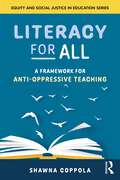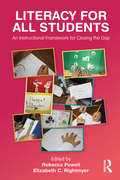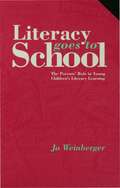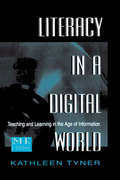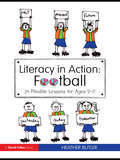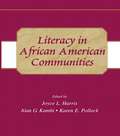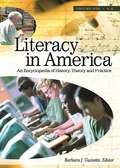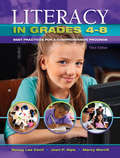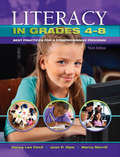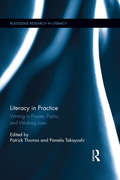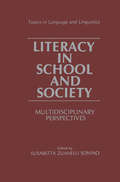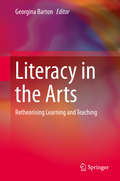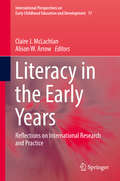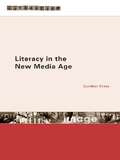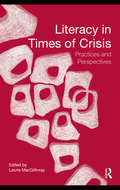- Table View
- List View
Literacy for All: A Framework for Anti-Oppressive Teaching (Equity and Social Justice in Education Series)
by Shawna CoppolaAn equity-conscious, culturally sustaining approach to literacy education. Every student comes to the classroom with unique funds of knowledge in addition to unique needs. How can teachers celebrate and draw upon the valuable literacies each child already possesses to engage them more effectively in school literacy practices? In Literacy for All, Shawna Coppola shows how a literacy pedagogy founded on anti-oppressive principles can transform the experiences of teachers and students alike. Using her framework, which highlights the social and cultural aspects of literacy, teachers can help students participate in literacy experiences that illuminate their individual strengths. Coppola’s book, an ideal introduction for equity-conscious literacy educators, shows how to design instructional and assessment practices that reflect both the cognitive processes and the social practices inherent in learning to read and write.
Literacy for All: A Framework for Anti-Oppressive Teaching (Equity and Social Justice in Education Series)
by Shawna CoppolaAn equity-conscious, culturally sustaining approach to literacy education. Every student comes to the classroom with unique funds of knowledge in addition to unique needs. How can teachers celebrate and draw upon the valuable literacies each child already possesses to engage them more effectively in school literacy practices? In Literacy for All, Shawna Coppola shows how a literacy pedagogy founded on anti-oppressive principles can transform the experiences of teachers and students alike. Using her framework, which highlights the social and cultural aspects of literacy, teachers can help students participate in literacy experiences that illuminate their individual strengths. Coppola’s book, an ideal introduction for equity-conscious literacy educators, shows how to design instructional and assessment practices that reflect both the cognitive processes and the social practices inherent in learning to read and write.
Literacy for All Students: An Instructional Framework for Closing the Gap
by Rebecca Powell Elizabeth RightmyerThe Culturally Responsive Instruction Observation Protocol (CRIOP) is a framework for implementing culturally relevant literacy instruction and classroom observation. Drawing on research and theory reflecting a range of perspectives ? multicultural instruction, literacy theory, equity pedagogy, language and discourse models, sheltered instruction, critical pedagogy ? it provides a means for assessing the many variables of classroom literacy instruction and for guiding practitioners in their development as multicultural educators. Literacy for All Students Discusses issues in multicultural literacy instruction within the context of various essential instructional components (such as assessment, curriculum, parent collaboration) Provides a protocol for observing features of literacy instruction for culturally and linguistically diverse students Presents vignettes from real classrooms, written by elementary and middle school teachers, showing their victories and struggles as they attempt to implement a pedagogy that is culturally responsive within a climate of high stakes testing A highly effective instrument for assessing culturally responsive literacy instruction in schools, the CRIOP serves as a model for realizing a literacy that is both relevant and transformative.
Literacy for All Students: An Instructional Framework for Closing the Gap
by Rebecca Powell Elizabeth RightmyerThe Culturally Responsive Instruction Observation Protocol (CRIOP) is a framework for implementing culturally relevant literacy instruction and classroom observation. Drawing on research and theory reflecting a range of perspectives ? multicultural instruction, literacy theory, equity pedagogy, language and discourse models, sheltered instruction, critical pedagogy ? it provides a means for assessing the many variables of classroom literacy instruction and for guiding practitioners in their development as multicultural educators. Literacy for All Students Discusses issues in multicultural literacy instruction within the context of various essential instructional components (such as assessment, curriculum, parent collaboration) Provides a protocol for observing features of literacy instruction for culturally and linguistically diverse students Presents vignettes from real classrooms, written by elementary and middle school teachers, showing their victories and struggles as they attempt to implement a pedagogy that is culturally responsive within a climate of high stakes testing A highly effective instrument for assessing culturally responsive literacy instruction in schools, the CRIOP serves as a model for realizing a literacy that is both relevant and transformative.
Literacy Goes to School: The Parents' Role in Young Children's Literacy Learning (PDF)
by Dr Jo Garber`Very accessible - not too technical or jargon-ridden. The practical suggestions were useful too - if professionals feel inspired to promote change in their practice and policy it is helpful to have suggestions on where to start and what to do' - Management in Education Few primary teachers have a chance to find out in detail what children have already learnt, and continue to learn, about literacy at home with their parents. This book gives a clear demonstration of literacy learning that takes place at home, and how it differs from, as well as relates to, literacy at school. It will help teachers to increase their understanding of this process and to build on their relationship with parents. Such understanding, the book shows, can directly enhance children's literacy performance in school.
Literacy in a Digital World: Teaching and Learning in the Age of Information (Routledge Communication Series)
by Kathleen TynerIn this book, Kathleen Tyner examines the tenets of literacy through a historical lens to demonstrate how new communication technologies are resisted and accepted over time. New uses of information for teaching and learning create a "disconnect" in the complex relationship between literacy and schooling, and raise questions about the purposes of literacy in a global, networked, educational environment. The way that new communication technologies change the nature of literacy in contemporary society is discussed as a rationale for corresponding changes in schooling. Digital technologies push beyond alphabetic literacy to explore the way that sound, image, and text can be incorporated into education. Attempts to redefine literacy terms--computer, information, technology, visual, and media literacies--proliferate and reflect the need to rethink entrenched assumptions about literacy. These multiple literacies are advanced to help users make sense of the information glut by fostering the ability to access, analyze, and produce communication in a variety of forms. Tyner explores the juncture between two broad movements that hope to improve education: educational technology and media education. A comparative analysis of these two movements develops a vision of teaching and learning that is critical, hands on, inquiry-based, and suitable for life in a mobile, global, participatory democracy.
Literacy in a Digital World: Teaching and Learning in the Age of Information (Routledge Communication Series)
by Kathleen TynerIn this book, Kathleen Tyner examines the tenets of literacy through a historical lens to demonstrate how new communication technologies are resisted and accepted over time. New uses of information for teaching and learning create a "disconnect" in the complex relationship between literacy and schooling, and raise questions about the purposes of literacy in a global, networked, educational environment. The way that new communication technologies change the nature of literacy in contemporary society is discussed as a rationale for corresponding changes in schooling. Digital technologies push beyond alphabetic literacy to explore the way that sound, image, and text can be incorporated into education. Attempts to redefine literacy terms--computer, information, technology, visual, and media literacies--proliferate and reflect the need to rethink entrenched assumptions about literacy. These multiple literacies are advanced to help users make sense of the information glut by fostering the ability to access, analyze, and produce communication in a variety of forms. Tyner explores the juncture between two broad movements that hope to improve education: educational technology and media education. A comparative analysis of these two movements develops a vision of teaching and learning that is critical, hands on, inquiry-based, and suitable for life in a mobile, global, participatory democracy.
Literacy in Action: 24 Flexible Lessons for Ages 9-11
by Heather ButlerGet ready for kick off and prepare to meet all of your literacy goals with Literacy in Action: Football. All year 5 and particularly year 6 teachers know about the pressure to help children deliver levels of achievement laid down by higher authorities than themselves. Many of the reluctant writers are passionate about football. Literacy in Action: Football could be the answer to their and your prayers, offering expert, tried and trusted techniques for teaching literacy, developed within the context of the 'Beautiful Game'. For those not bitten by the football bug there are alternative options. Literacy in Action: Football is a fun and inspiring addition to your literacy teaching. This unique classroom resource contains twenty-four lesson plans, each structured like a football match. For an hour, transform your classroom into Wembley Stadium! Each detailed lesson plan includes: short, kinaesthetic, focussed tasks with instant feedback and praise speaking and listening exercises – children engage in talking and collaborative work before completing a writing task key points from research in to boys’ writing in special notes for teachers alternative tasks available for those not interested in football differentiated material for a wide ability range. Literacy in Action: Football is written by Heather Butler, a writer, literacy consultant and story writing workshop leader. Literacy in Action: Football has been tested extensively by year 5 and year 6 teachers in leafy-green, inner city, multi-cultural and rural settings with amazing results. Why not try it for yourself?
Literacy in Action: 24 Flexible Lessons for Ages 9-11
by Heather ButlerGet ready for kick off and prepare to meet all of your literacy goals with Literacy in Action: Football. All year 5 and particularly year 6 teachers know about the pressure to help children deliver levels of achievement laid down by higher authorities than themselves. Many of the reluctant writers are passionate about football. Literacy in Action: Football could be the answer to their and your prayers, offering expert, tried and trusted techniques for teaching literacy, developed within the context of the 'Beautiful Game'. For those not bitten by the football bug there are alternative options. Literacy in Action: Football is a fun and inspiring addition to your literacy teaching. This unique classroom resource contains twenty-four lesson plans, each structured like a football match. For an hour, transform your classroom into Wembley Stadium! Each detailed lesson plan includes: short, kinaesthetic, focussed tasks with instant feedback and praise speaking and listening exercises – children engage in talking and collaborative work before completing a writing task key points from research in to boys’ writing in special notes for teachers alternative tasks available for those not interested in football differentiated material for a wide ability range. Literacy in Action: Football is written by Heather Butler, a writer, literacy consultant and story writing workshop leader. Literacy in Action: Football has been tested extensively by year 5 and year 6 teachers in leafy-green, inner city, multi-cultural and rural settings with amazing results. Why not try it for yourself?
Literacy in African American Communities
by Joyce L. Harris Alan G. Kamhi Karen E. PollockThis volume explores the unique sociocultural contexts of literacy development, values, and practices in African American communities. African Americans--young and old--are frequently the focus of public discourse about literacy. In a society that values a rather sophisticated level of literacy, they are among those who are most disadvantaged by low literacy achievement. Literacy in African American Communities contributes a fresh perspective by revealing how social history and cultural values converge to influence African Americans' literacy values and practices, acknowledging that literacy issues pertaining to this group are as unique and complex as this group's collective history. Existing literature on literacy in African American communities is typically segmented by age or academic discipline. This fragmentation obscures the cyclical, life-span effects of this population's legacy of low literacy. In contrast, this book brings together in a single-source volume personal, historical, developmental, and cross-disciplinary vantage points to look at both developmental and adult literacy from the perspectives of education, linguistics, psychology, anthropology, and communication sciences and disorders. As a whole, it provides important evidence that the negative cycle of low literacy can be broken by drawing on the literacy experiences found within African American communities.
Literacy in African American Communities
by Joyce L. Harris Alan G. Kamhi Karen E. PollockThis volume explores the unique sociocultural contexts of literacy development, values, and practices in African American communities. African Americans--young and old--are frequently the focus of public discourse about literacy. In a society that values a rather sophisticated level of literacy, they are among those who are most disadvantaged by low literacy achievement. Literacy in African American Communities contributes a fresh perspective by revealing how social history and cultural values converge to influence African Americans' literacy values and practices, acknowledging that literacy issues pertaining to this group are as unique and complex as this group's collective history. Existing literature on literacy in African American communities is typically segmented by age or academic discipline. This fragmentation obscures the cyclical, life-span effects of this population's legacy of low literacy. In contrast, this book brings together in a single-source volume personal, historical, developmental, and cross-disciplinary vantage points to look at both developmental and adult literacy from the perspectives of education, linguistics, psychology, anthropology, and communication sciences and disorders. As a whole, it provides important evidence that the negative cycle of low literacy can be broken by drawing on the literacy experiences found within African American communities.
Literacy in America [2 volumes]: An Encyclopedia of History, Theory, and Practice [2 volumes]
by Barbara J. GuzzettiThe definitive encyclopedic resource on literacy, literacy instruction, and literacy assessment in the United States.Once upon a time, the three "R"s sufficed. Not any more—not for students, not for Americans. Gone the way of the little red school house is simple reading and writing instruction. Surveying an increasingly complex discipline, Literacy in America: An Encyclopedia offers a comprehensive overview of all the latest trends in literacy education—conceptual understanding of texts, familiarity with electronic content, and the ability to create meaning from visual imagery and media messages.Educators and academicians call these skills "multiple literacies," shorthand for the kind of literacy skills and abilities needed in an age of information overload, media hype, and Internet connectedness. With its 400 A–Z entries, researched by experts and written in accessible prose, Literacy in America is the only reference tool students, teachers, and parents will need to understand what it means to be—and become—literate in 21st-century America.
Literacy in Grades 4-8: Best Practices for a Comprehensive Program
by Nancy L. Cecil Joan P. Gipe Merrill E. MarcyComprehensive yet succinct and readable, Literacy in Grades 4-8, Third Edition offers a wealth of practical ideas to help preservice and practicing teachers create a balanced and comprehensive literacy program while exploring the core topics and issues of literacy in grades 4 through 8. It addresses teaching to standards; differentiating instruction for readers and writers; motivating students; using assessment to inform instruction; integrating technology into the classroom; working with English learners and struggling readers; and connecting with caregivers. Selected classroom strategies, procedures, and activities represent the most effective practices according to research and the many outstanding classroom teachers who were observed and interviewed for the book. The Third Edition includes added material connecting the Common Core State Standards to the instruction and assessment of literacy skills; a combined word study and vocabulary chapter to help readers integrate these important topics in their teaching; more on technology, including comprehension of multimodal texts, enhancing writing instruction with technology tools, and teaching activities with an added technology component; added discussion of teacher techniques during text discussions, strategic moves that help students become more strategic readers.Key features: In the Classroom vignettes; more than 50 activities,some with a technology component; questions for journal writing and for projects and field-based activities; troubleshooting sections offering alternative suggestions and activities for those middle-grade students who may find a particular literacy focus challenging.
Literacy in Grades 4-8: Best Practices for a Comprehensive Program
by Nancy L. Cecil Joan P. Gipe Merrill E. MarcyComprehensive yet succinct and readable, Literacy in Grades 4-8, Third Edition offers a wealth of practical ideas to help preservice and practicing teachers create a balanced and comprehensive literacy program while exploring the core topics and issues of literacy in grades 4 through 8. It addresses teaching to standards; differentiating instruction for readers and writers; motivating students; using assessment to inform instruction; integrating technology into the classroom; working with English learners and struggling readers; and connecting with caregivers. Selected classroom strategies, procedures, and activities represent the most effective practices according to research and the many outstanding classroom teachers who were observed and interviewed for the book. The Third Edition includes added material connecting the Common Core State Standards to the instruction and assessment of literacy skills; a combined word study and vocabulary chapter to help readers integrate these important topics in their teaching; more on technology, including comprehension of multimodal texts, enhancing writing instruction with technology tools, and teaching activities with an added technology component; added discussion of teacher techniques during text discussions, strategic moves that help students become more strategic readers.Key features: In the Classroom vignettes; more than 50 activities,some with a technology component; questions for journal writing and for projects and field-based activities; troubleshooting sections offering alternative suggestions and activities for those middle-grade students who may find a particular literacy focus challenging.
Literacy in Grades 4-8: Best Practices for a Comprehensive Program
by Nancy L. Cecil Gipe P. Joan Merrill E. MarcyComprehensive yet succinct and readable, Literacy in Grades 4-8, Third Edition offers a wealth of practical ideas to help preservice and practicing teachers create a balanced and comprehensive literacy program while exploring the core topics and issues of literacy in grades 4 through 8. It addresses teaching to standards; differentiating instruction for readers and writers; motivating students; using assessment to inform instruction; integrating technology into the classroom; working with English learners and struggling readers; and connecting with caregivers. Selected classroom strategies, procedures, and activities represent the most effective practices according to research and the many outstanding classroom teachers who were observed and interviewed for the book. The Third Edition includes added material connecting the Common Core State Standards to the instruction and assessment of literacy skills; a combined word study and vocabulary chapter to help readers integrate these important topics in their teaching; more on technology, including comprehension of multimodal texts, enhancing writing instruction with technology tools, and teaching activities with an added technology component; added discussion of teacher techniques during text discussions, strategic moves that help students become more strategic readers.Key features: In the Classroom vignettes; more than 50 activities,some with a technology component; questions for journal writing and for projects and field-based activities; troubleshooting sections offering alternative suggestions and activities for those middle-grade students who may find a particular literacy focus challenging.
Literacy in Grades 4-8: Best Practices for a Comprehensive Program
by Nancy L. Cecil Gipe P. Joan Merrill E. MarcyComprehensive yet succinct and readable, Literacy in Grades 4-8, Third Edition offers a wealth of practical ideas to help preservice and practicing teachers create a balanced and comprehensive literacy program while exploring the core topics and issues of literacy in grades 4 through 8. It addresses teaching to standards; differentiating instruction for readers and writers; motivating students; using assessment to inform instruction; integrating technology into the classroom; working with English learners and struggling readers; and connecting with caregivers. Selected classroom strategies, procedures, and activities represent the most effective practices according to research and the many outstanding classroom teachers who were observed and interviewed for the book. The Third Edition includes added material connecting the Common Core State Standards to the instruction and assessment of literacy skills; a combined word study and vocabulary chapter to help readers integrate these important topics in their teaching; more on technology, including comprehension of multimodal texts, enhancing writing instruction with technology tools, and teaching activities with an added technology component; added discussion of teacher techniques during text discussions, strategic moves that help students become more strategic readers.Key features: In the Classroom vignettes; more than 50 activities,some with a technology component; questions for journal writing and for projects and field-based activities; troubleshooting sections offering alternative suggestions and activities for those middle-grade students who may find a particular literacy focus challenging.
Literacy in Practice: Writing in Private, Public, and Working Lives (Routledge Research in Literacy)
by Patrick Thomas Pamela TakayoshiThe rise of New Literacy Studies and the shift from studying reading and writing as a technical process to examining situated literacies—what people do with literacy in particular social situations—has focused attention toward understanding the connections between reading and writing practices and the broader social goals and cultural practices these literacy practices help to shape. This collection brings together situated research studies of literacy across a range of specific contexts, covering everyday, educational, and workplace domains. Its contribution is to provide, through an empirical framework, a larger cumulative understanding of literacy across diverse contexts.
Literacy in Practice: Writing in Private, Public, and Working Lives (Routledge Research in Literacy #7)
by Patrick Thomas Pamela TakayoshiThe rise of New Literacy Studies and the shift from studying reading and writing as a technical process to examining situated literacies—what people do with literacy in particular social situations—has focused attention toward understanding the connections between reading and writing practices and the broader social goals and cultural practices these literacy practices help to shape. This collection brings together situated research studies of literacy across a range of specific contexts, covering everyday, educational, and workplace domains. Its contribution is to provide, through an empirical framework, a larger cumulative understanding of literacy across diverse contexts.
Literacy in School and Society: Multidisciplinary Perspectives (Topics in Language and Linguistics)
by Elizabetta Zuanelli SoninoThe "function" and "notion" of literacy may be considered the keystone, a "filigree" principle underlying the educational, social, and cultural organiza tion of the societies of the twentieth century. It is therefore interesting to try to pinpoint the notion and its implications at the tum of the century by focusing the attention of scholars from various disciplines-sociolinguistics, psychology, psycholinguistics, and pedagogy-on the subject. This is the purpose of this volume, which originated from an inter disciplinary meeting on trends in and problems of research on early literacy through mother tongues and/or second languages, held in Venice under the auspices of the University of Venice, and in particular of the Seminario di Linguistica e di Didattica della Lingue and the Centro Linguistico Interfacolta, and the Municipality of Venice, together with UNESCO and AILA. A first far-reaching question touches on the role assigned to or fulfilled by mass "literacy" in modem society. The concept of literacy considered as a social achievement, an essential component in the process of education to be institutionally prompted and controlled, fluctuates between two opposite poles. A polemic-destructive view considers the notion and the educational "prac tices" connected with it as a potent instrument of social control, a tool for social reproduction and consensus. On the other side, a plurifunctional con structive view considers the acquisition and maintenance of different languages via educational institutions as a concrete possibility for the defense and main tenance of cultural pluralism and identity, be it social, ethnic, or religious.
Literacy in the Arts: Retheorising Learning and Teaching
by Georgina BartonThis book explores the many dialogues that exist between the arts and literacy. It shows how the arts are inherently multimodal and therefore interface regularly with literate practice in learning and teaching contexts. It asks the questions: What does literacy look like in the arts? And what does it mean to be arts literate? It explores what is important to know and do in the arts and also what literacies are engaged in, through the journey to becoming an artist. The arts for the purpose of this volume include five art forms: Dance, Drama, Media Arts, Music and Visual Arts. The book provides a more productive exploration of the arts-literacy relationship. It acknowledges that both the arts and literacy are open-textured concepts and notes how they accommodate each other, learn about, and from each other and can potentially make education ‘better’. It is when the two stretch each other that we see an educationally productive dialogic relationship emerge.
Literacy in the Early Years: Reflections on International Research and Practice (International Perspectives on Early Childhood Education and Development #17)
by Claire J. McLachlan Alison W. ArrowThis edited collection provides an in-depth exploration of different aspects of contemporary early childhood literacy research and the implications for educational practice. Each chapter details how the research was conducted and any issues that researchers encountered in collecting data with very young children, as well as what the research findings mean for educational practice. It includes photographs of effective literacy practice, detailed explanations of research methods so the studies can be replicated or expanded upon, and key features for promoting effective literacy practice in early childhood settings. This book is an essential read for everyone who is interested in exploring the complexities and challenges of researching literacy acquisition in the youngest children.
Literacy in the New Media Age (Literacies)
by Gunther KressIn this 'new media age' the screen has replaced the book as the dominant medium of communication. This dramatic change has made image, rather than writing, the centre of communication. In this groundbreaking book, Gunther Kress considers the effects of a revolution that has radically altered the relationship between writing and the book. Taking into account social, economic, communication and technological factors, Kress explores how these changes will affect the future of literacy. Kress considers the likely larger-level social and cultural effects of that future, arguing that the effects of the move to the screen as the dominant medium of communication will produce far-reaching shifts in terms of power - and not just in the sphere of communication. The democratic potentials and effects of the new information and communication technologies will, Kress contends, have the widest imaginable consequences. Literacy in the New Media Age is suitable for anyone fascinated by literacy and its wider political and cultural implications. It will be of particular interest to those studying education, communication studies, media studies or linguistics.
Literacy in the New Media Age (Literacies)
by Gunther KressIn this 'new media age' the screen has replaced the book as the dominant medium of communication. This dramatic change has made image, rather than writing, the centre of communication. In this groundbreaking book, Gunther Kress considers the effects of a revolution that has radically altered the relationship between writing and the book. Taking into account social, economic, communication and technological factors, Kress explores how these changes will affect the future of literacy. Kress considers the likely larger-level social and cultural effects of that future, arguing that the effects of the move to the screen as the dominant medium of communication will produce far-reaching shifts in terms of power - and not just in the sphere of communication. The democratic potentials and effects of the new information and communication technologies will, Kress contends, have the widest imaginable consequences. Literacy in the New Media Age is suitable for anyone fascinated by literacy and its wider political and cultural implications. It will be of particular interest to those studying education, communication studies, media studies or linguistics.
Literacy in Times of Crisis: Practices and Perspectives
by Laurie MacGillivray"Fresh, provocative, timely, and important, this volume extends the field of sociocultural literacies in new directions."--Marjorie Faulstich Orellana, University of California, Los Angeles On the frontline of critical issues in education today, this book covers new ground for teachers and teacher educators for whom crisis is a daily part of their work. It explores the relationship between crisis and literacy in order to: improve educators’ ability to recognize, cope with, and avoid crisis; advance understanding of the dynamic relationship between crisis and cultural, historical, and political literacy practices; and contribute to a deeper theoretical understanding of literacy practices as they are situated in social practices. The types of crises addressed are diverse, including natural disaster, cultural and community disjuncture, homelessness, family upheaval, teen pregnancy, and disability. Along with nine empirical studies, a teacher early in her career, a veteran teacher, and teacher educators share their perspectives in commentary sections at the opening and conclusion of the book in order to provide applications to their specific fields.
Literacy in Times of Crisis: Practices and Perspectives
by Laurie MacGillivray"Fresh, provocative, timely, and important, this volume extends the field of sociocultural literacies in new directions."--Marjorie Faulstich Orellana, University of California, Los Angeles On the frontline of critical issues in education today, this book covers new ground for teachers and teacher educators for whom crisis is a daily part of their work. It explores the relationship between crisis and literacy in order to: improve educators’ ability to recognize, cope with, and avoid crisis; advance understanding of the dynamic relationship between crisis and cultural, historical, and political literacy practices; and contribute to a deeper theoretical understanding of literacy practices as they are situated in social practices. The types of crises addressed are diverse, including natural disaster, cultural and community disjuncture, homelessness, family upheaval, teen pregnancy, and disability. Along with nine empirical studies, a teacher early in her career, a veteran teacher, and teacher educators share their perspectives in commentary sections at the opening and conclusion of the book in order to provide applications to their specific fields.
